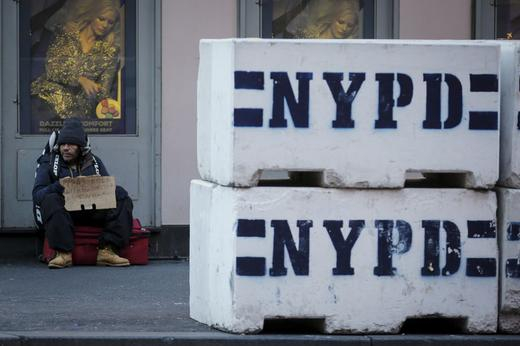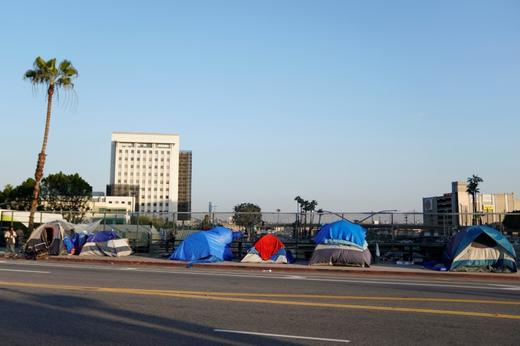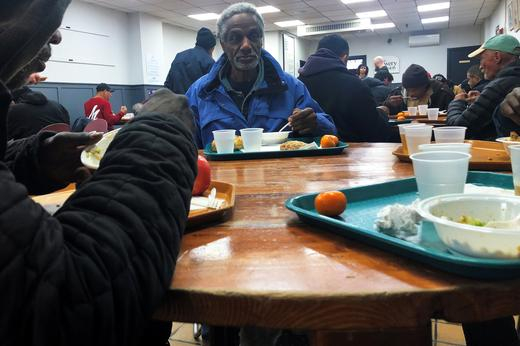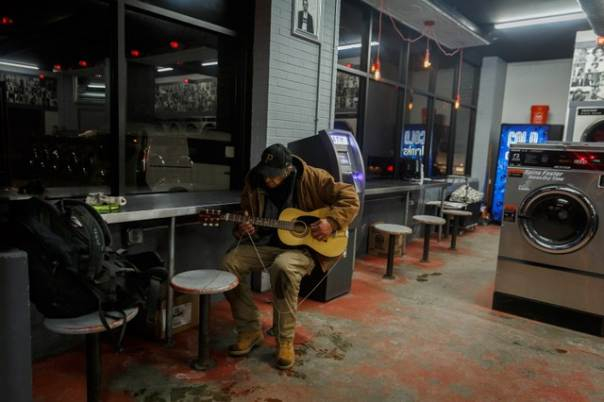The most common ways of limiting exposure to coronavirus, like social distancing, stay at home, and early testing, are nearly impossible for one significant segment of the U.S. population — those experiencing homelessness.
Around 3,600 people live on New York City's streets. During the day, they seek shelter in subway trains, and at night in public parks. More than 58,000 live in shelters, where up to 12 beds, sometimes even 20, are placed in one single room.
According to data from the U.S. Department of Housing and Urban Development, more than 560,000 individuals surveyed on one night in 2019 experienced homelessness. Among those with the largest homeless population, New York City, Los Angeles, and Seattle, all are densely populated cities facing a housing crisis, making expanding access to quarantine space and basic hygienic services more difficult amid the pandemic.

A homeless man sits on 42nd Street in the Manhattan borough of New York, January 4, 2016. /Reuters
A homeless man sits on 42nd Street in the Manhattan borough of New York, January 4, 2016. /Reuters
Theo Henderson, host of the "We the Unhoused" podcast, has been living on the streets of Los Angeles for seven years. In his most recent podcast episode, he listed the difficulties the unhoused community in LA is going through trying to cope with the pandemic.
Increased police operations that takes down homeless people's tents during the day makes it harder for the homeless to have social-distancing. Sleeping in a car in residential areas or near schools, parks and daycare units is illegal under the city's law.
Public libraries and parks, the few spots in the city where clean bathrooms and washing stations were available to the homeless, remain shut down. And many Starbucks stores have tried removing phone chargers to penalize and discourage the homeless from coming into the store.
With the economy in slow motion, the fear of eviction became real. Especially for those who had multiple part-time temporary jobs, the business shutdown is taking away major chunks of their paycheck. "To penalize them for not paying the rent because our economy and our system has shut down through a pandemic is cruel, illegal, and wrong," said Henderson.

Tents and tarps on the sidewalk of a freeway overpass home to hundreds of homeless living on the streets of Los Angeles, January 22, 2020. /Reuters
Tents and tarps on the sidewalk of a freeway overpass home to hundreds of homeless living on the streets of Los Angeles, January 22, 2020. /Reuters
Amid public outcry for helping individuals struggling to respond to the outbreak, the LA City Council on Wednesday decided to pass legislation to enact basic protections. Measures include eviction moratorium to cover everyone who missed rent. Enforcement of tents down during the day will be suspended amid the crisis.
On the other side of the country, concerns about the transmission of COVID-19 among the homeless are rising on the East Coast, when it was reported on Tuesday that a resident of a New York City homeless shelter tested positive for coronavirus. This was the first case of its kind as the city braced for an escalation of coronavirus outbreak.
Health officials have long feared that an outbreak could occur in homeless shelters where residents live in close range. Because residents do not have the ability to self-quarantine, access to separate space and medical help are of crucial importance to shelters with infected cases.
According to U.S. media, the resident who tested positive in New York City shelter is now hospitalized in isolation. The resident's eight dorm mates were transferred to a separate quarantine location established by the Department of Homeless Services for dealing with the coronavirus pandemic.

A homeless man eats lunch inside a homeless shelter in New York, U.S., March 10, 2020. /Reuters
A homeless man eats lunch inside a homeless shelter in New York, U.S., March 10, 2020. /Reuters
To prevent cross-infection in over-crowded shelters, staffs at the shelter have been modifying their operation methods. In a 11-page document issued by the New York City, beds are advised to be at least three to six feet apart. Shared eating is also strongly discouraged, as well as group activities.
But to live up to the requirements, sheltering fewer people seems to be an inevitable choice. Shelters across the country report a halt on new intake. Transition Project, the largest provider of shelter services in Portland, announced that it would stop taking in new guests across their shelters as of last week to make more space.
The aging trend among the homeless population makes them even more vulnerable. Many have underlying health conditions that weaken their immune system.
In 2017, a hepatitis A outbreak swept across San Diego, Santa Cruz, and Los Angeles counties leading to the death of 600 people, most of them homeless. The virus, which spread easily between people through contaminated food or drinking water, hit hard the homeless community, for the similar reasons that make homeless people vulnerable to the COVID-19 pandemic.

A homeless man plays guitar at a laundromat during the hours in which shelters are not open in Pittsburgh, Pennsylvania, January 7, 2018. /Reuters
A homeless man plays guitar at a laundromat during the hours in which shelters are not open in Pittsburgh, Pennsylvania, January 7, 2018. /Reuters
Yet hepatitis A vaccines were available when the 2017 outbreak happened. But for COVID-19, no vaccine is yet in sight.
On a positive note, some adjustment measures have been taken on the part of state and federal governments. The Department and Homeless Services recently overruled the previous policy that forbids outreach officers from handing out supplies to homeless people on the street. Hand sanitizers and socks are distributed to the homeless population in a bid to help them cope with the coronavirus.
Greater efforts have been put into pulling the homeless off the streets. Modular tents and camp trailers were deployed as temporary shelters across several states. California blocked off nearly 400 rooms in two hotels and will purchase more than 1,300 trailers for homeless individuals, who tested positive for COVID-19 or who are at greater risk of infection.
Yet, in the longer term, the solution is to ensure housing availability. The poorest 24 percent of U.S. population spends more than half of their income on rent, and the lack of affordable housing is the primary cause of homelessness, especially among families. As Koreatown for All, the organization pushing for LA City Council to enact protections for the homeless amid coronavirus puts it, "shelter beds cannot replace the goal of housing people permanently."
(Cover photo: A homeless woman sits bundled against the cold as she begs on East 42nd Street in Manhattan, New York City, January 4, 2016. /Reuters)